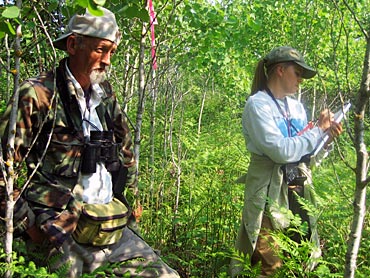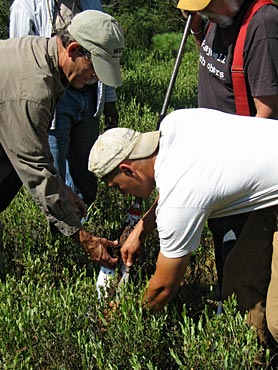At home in the Northwoods
Woodruff, Wis. — The sun is still slumbering below the horizon and the trees are thick with dew as a pair of researchers pause in a young stand of aspen, listening intently to a twittered song.

Researchers Ron Hull, left, and Amber Roth catalog bird species in aspen forests near Kemp Natural Resources Station in Woodruff, Wis. The two are among dozens of scientists who draw upon the station’s facilities while conducting natural resources research in northern Wisconsin.
Photo: Jill Sakai
"White-throated sparrow, 18 meters to the left."
Most summer sunrises find Amber Roth and Ron Hull cataloguing bird species in one of several aspen plots scattered around north central Wisconsin. Each day, the two rise with the early bird, ward off bugs and briars, and delicately bushwhack through brushy forests to look and listen for their feathered inhabitants.
Roth and Hull are just two of dozens of seasonal residents at the Kemp Natural Resources Station in Woodruff, Wis. One of 13 field stations throughout the state run by the University of Wisconsin–Madison College of Agricultural and Life Sciences, Kemp Station is dedicated to research and education about Wisconsin’s natural resources.
The station is located on the former Kemp family estate on the shores of picturesque Lake Tomahawk, in the Minocqua chain of lakes. The grounds and original log buildings, gifted to UW–Madison by the family in 1960, now offer research and temporary residential facilities for visiting scientists. The station also hosts university classes and offers public education and outreach programs on topics ranging from climate change to sport fish populations.
"Kemp is a nice presence of UW–Madison here in the Northwoods," where the flagship UW System campus is less familiar than nearer campuses like UW-Stevens Point, says interim superintendent Scott Craven.
Summer is high season at the station, when a series of classes, researchers and visitors stream onto Kemp grounds. For most, Kemp serves as a home base for research projects that require access to woods, water, wildlife or wilderness. This summer, the station is hosting people studying topics ranging from climate change to lakeshore ecology to biodiversity.
Though many of the scientists hail from UW–Madison, Kemp Station also welcomes natural resources researchers from other schools and organizations. For example, Roth’s work is part of a large Michigan Technological University project to balance wildlife management and the possible harvesting of aspen to make a biofuel called cellulosic ethanol.
While Kemp’s location in the heart of the Northwoods provides proximity to a variety of natural ecosystems and environmental resources, the station offers more than just a place to sleep. Laboratory and computer facilities on site can help with data analysis and communication with off-site collaborators. Residential facilities, including the brand-new Mead Residence Hall, can house nearly 70 people at a time and offer meeting areas and kitchen space.
Jo Horton, a UW–Madison student pursuing a double major in wildlife ecology and landscape architecture, calls Kemp her "home away from home." Though she lives in Madison, she is bunking at the station for the entire summer while working on an old-growth forest project with the Wisconsin Department of Natural Resources. She finds it a place to "recoup and recharge" after a long day in the field. "It’s nice to interact with other people and find out what they’re doing," she says.
Though a far cry from a five-star resort, the creature comforts at the research station can make the hard work of field research easier to cope with. "I think if we were camping I would have mutiny," laughs Roth about her six field crew members, who log long weeks in sometimes unforgiving conditions.
The facilities also provide opportunities for classes that can spend anywhere from a few hours to several weeks at Kemp Station. Recently the lodge and cabin played host to a UW–Madison graduate level soil science class led by soil science professors Fred Madison and Birl Lowery.

Limnologist Tim Kratz, left, and teaching assistant Nic Jelinski collect soil samples from a peat bog to share with a UW–Madison soil science class. The class stayed at the Kemp Station while exploring the soils and landscapes of northern Wisconsin.
Photo: Jill Sakai
Madison took his students on a statewide tour for three weeks of hands-on, on-site learning, finishing with several days at Kemp to get their hands dirty in the soils and landscape features of northern Wisconsin. "We get kids who’ve been studying soils for years but have never seen one," he says.
The nomadic course design lets the whole state become their classroom, drawing on instructors with real-world perspectives: a U.S. Forest Service soil mapping expert, a pig farmer, a commercial cranberry producer. Madison feels the diverse viewpoints are as integral to the class as the information they convey, giving voice to some of the often-competing interests in soils and resource management issues.
"I could teach all this stuff myself," says Madison. "But the kids will learn so much more hearing it from other people."
During one of their final lessons, the young scientists tromp through the Big Muskellunge Lake bog, getting their feet wet — literally — while learning about peatlands and bog formation from Tim Kratz, a scientist in the UW–Madison Center for Limnology and director of the nearby Trout Lake Station.
The instructors use a special corer to pull a series of sediment cores from the peat, down to a depth of about 30 feet. "We can read history in the sediments," Kratz says as he points out distinct layers of the cores that correspond to different chapters of the bog’s life.
As the students compare the texture and contents of different cores with now-muddy hands, warm and fibrous layers soon give way to colder, drier layers of fine textured sediment from an ancient lakebed. "It’s strange to be touching something thousands of years old," remarks one student with a touch of awe.
The students enjoy getting outside and seeing their subjects in a natural context. "It gives us a chance to take what we’ve learned and really use it," says Nina Trautmann, a third-year graduate student in the Land Resources Program at the Nelson Institute for Environmental Studies. "I can read a book and it doesn’t sink in, but then I go out and see it and think, ‘Now I understand!’"
And with the sun beaming overhead, dragonflies buzzing by, and the bog squelching underfoot, it’s hard to imagine a better classroom.




